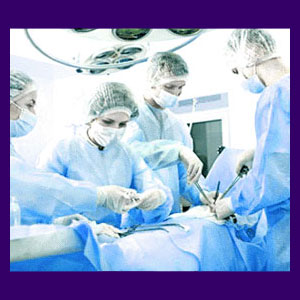
Nucleoplasty is a revolutionary procedure designed to decompress intact and structurally sound herniated discs. It is sometimes referred to by the name percutaneous discectomy. This surgical procedure is minimally invasive, using a super thin catheter to gain access to the interior of the bulging disc. A tiny radio transmitter is inserted into the disc nucleus through the catheter. This transmitter emits radio waves that break-up the organic material in the nucleus, decreasing the amount of nucleus material putting pressure on the distorted annulus fibrosus of the bulging disc.
When successfully executed, this operative procedure will cause the disc to shrink back to its original size and shape, eliminating painful pressure on the affected spinal nerve root. The nucleoplasty procedure is performed under local anesthetic and only takes about 30 minutes to complete. The patient can go home immediately. Most patients return to work in about a week and are instructed to limit vigorous physical activity for a few weeks.
This article examines the usefulness of percutaneous discectomy for treating particular varieties of herniated disc concerns.
Advantages of Nucleoplasty
The operation is extremely precise and does not remove more tissue than is necessary to shrink the disc. If too much nucleus tissue is removed, the disc will shrink more than necessary. In this case, the disc will suffer from an artificially-created version of degenerative disc disease, instead of being herniated.
The percutaneous discectomy procedure offers good results with little risk taken by the patient. A more involved surgery can always be performed if the outcome is poor. The procedure is relatively comfortable and should leave no scar tissue or physical limitations, as long as no serious complications occur.
Statistically, percutaneous discectomy does very well when compared to more invasive variants of disc surgery. However, all is not perfect when it comes to using this technique to treat symptomatic intervertebral pathologies.
Warnings for Percutaneous Discectomy
Percutaneous discectomy is designed specifically for bulging discs in which the external disc wall is intact. This procedure should not be used for extruded or ruptured discs. The technique is also not advised for discs suffering from an annular tear.
Percutaneous discectomy demonstrates the best results for treating herniated lumbar discs which are causing sciatica pain in the legs. Instances where back pain is the chief complaint are far less often resolved, since these are not caused by a compressive neuropathy in most cases.
While well tolerated in most patients, there are always the usual risks of any surgical event to consider. There is a small risk of infection, as well as rare cases of nerve damage or scar tissue formation. If general anesthesia is utilized for any reason, this will increase risk factors substantially. The most common risk to consider is the incidence of re-herniations which occur in a great number of patients immediately or eventually.
Nucleoplasty Considerations
If you have not achieved good results with conservative treatments for chronic disc pain, then this procedure might be a good option to consider. Of course, you must actually be suffering from enclosed herniated disc as the definitive cause of your pain in order to be indicated to receive percutaneous discectomy therapy.
If your condition meets the requirements for this operation and you have considered minimally invasive surgery, then this procedure is certainly a strong contender. It would be wise to try this approach to care before any other type of drastic surgery to correct the bulging disc. You have little to lose by trying and you might enjoy complete disc pain relief.
Just remember that most bulging discs are not symptomatic, although they are often unjustly accused of causing pain. If the disc issue exists, but is not the source of discomfort, then “fixing” it will do nothing to relieve symptoms. This explains why a large number of postoperative patients demonstrate great anatomical results, but still have terrible symptoms after treatment.





